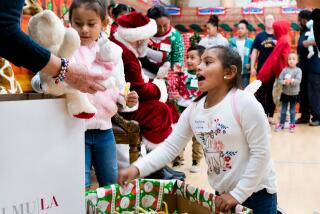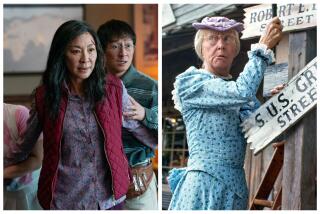Fooling nature, and the fertility doctor
- Share via
The walls of his Westwood Village fertility clinic are lined with happy snapshots of moms and dads proudly showing off their little bundles of joy.
But there was little jubilation Monday for Dr. Vicken Sahakian as he acknowledged that one of his patients had become the world’s oldest new mother.
“Congratulations? It was unintentionally successful,” Sahakian said. “She lied to me. She falsified records, knowing my cutoff for single women is 55....I don’t think the last chapter has been closed, either. She could die 10 years from now. What will happen to the children?”
Carmela Bousada, a 67-year-old retired Spanish department store clerk, gave birth to twin boys Dec. 29 in Barcelona. Over the weekend, the single mother admitted to European reporters that she had deceived Sahakian in order to become pregnant.
The birth of 3-pound, 7-ounce Pau and 3-pound, 5-ounce Christian -- who were premature -- roiled the world of fertility medicine Monday and raised a basic question: How old is too old?
Dr. Richard J. Paulson, director of the USC Fertility clinic, said the easier determination is the physiological one. Women over 50 face an increased risk of pregnancy complications, such as diabetes and high blood pressure.
“That reaches an almost prohibitive level at 55,” Paulson said. “Most clinics won’t treat women over 55. We’re one of the few mainstream clinics that treat over 50.... Most mainstream clinics stop at 50.”
Paulson’s clinic has required a photo identification before treating any patient since he unwittingly helped a woman in her 60s become pregnant. When she started infertility treatment, she said she was 53 -- two years younger than USC’s cutoff. She underwent a barrage of screening tests and produced medical records attesting to her age.
But when she became pregnant, she fessed up. Her healthy baby daughter was born in 1996, when the woman was 63, making hers the oldest successful pregnancy on record at the time.
Paulson believes a cutoff of 55 is appropriate, but he resists the call for greater government regulation that might create a legal age limit.
“As soon as you get into an area of zero tolerance, it’s easy to find a case when regulation becomes wrong or harmful,” Paulson said in an interview Monday. “To go and try to interfere with someone’s reproductive rights is a very touchy area.”
No one foresees a run on obstetrical care for the 60-and-up set. Still, every time someone in her 60s delivers, there’s a media frenzy. Even the AARP magazine has featured a long spread answering the question “What’s it like to be changing diapers at 50?”
But bioethicist Arthur Caplan, author of “Smart Mice, Not So Smart People,” believes technology has zoomed past society’s ability to deal with its ramifications and that legislators have ducked their responsibility to regulate its use. The more pressing issue, he said, is not necessarily the parents’ age but that “Someone has to look out for the best interests of children.”
Although the story of the oldest mother in the world has raised its share of outrage, some see a double standard in all the fuss. Although there is some discussion linking a rise in autism with aging sperm, old fathers generally raise fewer eyebrows than old mothers.
Think Strom Thurmond, Tony Randall, Larry King and Clint Eastwood, says Caplan, noting that “even when they have those kids and die, they’ve always had to have partners young enough to bear children. There’s always been a parent there.”
One major question raised by critics is whether aging parents will be able to cope with toddlers at retirement age.
But to Jan Andersen, who runs mothersover40.com, that should be the least of society’s worries.
“That’s like taking a 25-year-old parent with seven kids living on welfare, who smokes and abuses her children, and saying that she’s a good parent just because she’s young,” she wrote.
That is a sentiment shared by Bousada, who in an interview Sunday with London’s News of the World newspaper said age shouldn’t be a barrier to becoming a new mother.
“Everyone has to have children at the right time for them. This was the right time for me,” she said. “It was something I’ve always dreamed of.”
In the Wilshire Boulevard offices of the Pacific Fertility Center, where the 20-seat waiting room is decorated with sculptures of women holding children as well as with thumbtacked photos of hundreds of smiling babies -- many of them twins and triplets -- and their parents, Sahakian was shaking his head over his record-breaking patient.
He said Bousada had claimed to be 55 and had Spanish medical lab paperwork sent to his office indicating that was her age.
“I feel duped and taken advantage of,” he said. “It could have had a bad ending. She could have died, the babies could have died.”
The 44-year-old specialist said he has worked with a few women ages 55 and 56, and one patient who was 62. But such older women must have a husband in his 40s, he said.
“I’ll treat a woman when the combined age of mother and father is no more than 110. Fifty-five is my cutoff for single women,” he said.
Women older than 60 generally get pregnant in one of two ways. An egg is usually obtained from a younger woman. It is then fertilized in the laboratory with the sperm of the older woman’s partner or a donor. After three days, the embryo is transferred to the uterus, where it implants after about four more days.
Or a woman can use donated embryos. Typically, between one and three embryos are transferred; more embryos increase the chance of success.
Bousada received eggs from an 18-year-old brunet; the sperm was from a blond, blue-eyed Italian American.
Sahakian said he had heard news reports of the Dec. 29 birth but did not recognize the mother as one of his patients. He said he learned her identity over the weekend from a reporter. He was stunned when he realized that she was 66 when he treated her. She turned 67 seven days after her twins’ birth.
“We don’t ask for a passport or birth certificate,” he said. “When you go to the doctor, you’re supposed to tell the truth.”
Bousada is living with her infant sons in a one-bedroom apartment after selling her home for about $60,000 to pay the cost of traveling to the United States and in-vitro fertilization, according to the British press. Her Pacific Fertility medical costs came to about $10,000 in doctor fees, plus $30,000 for the egg donation.
Her pregnancy wasn’t easy, Bousada told the British media. Once, she was rushed to a hospital after collapsing in a supermarket. She was retaining so much water that Spanish doctors feared her kidneys were failing. Physicians were so concerned when it came time for the caesarean delivery that they summoned family members to her Barcelona bedside. Born prematurely -- they were due Feb. 8 -- the twin boys had to be placed in incubators.
Bousada said she is looking for a younger man to marry and be the father of her sons.
In the meantime, she’s planning to buy a playpen.
*
maria.laganga@latimes.com








